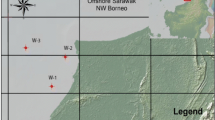Abstract
Determination of petrophysical parameters by using available data has a specific importance in exploration and production studies for oil and gas industries. Modeling of corrected permeability as a petrophysical parameter can help in decision making processes. The objective of this study is to construct a comprehensive and quantitative characterization of a carbonate gas reservoir in marine gas field. Artificial neural network is applied for prediction of permeability in accordance with other petrophysical parameters at well location. Correlation coefficient for this method is 84 %. In the study, the geological reservoir model is developed in two steps: First, the structure skeleton of the field is constructed, and then, reservoir property is distributed within it by applying new stochastic methods. Permeability is modeled by three techniques: kriging, sequential Gaussian simulation (SGS) and collocated co-simulation using modeled effective porosity as 3D secondary variable. This paper enhances the characterization of the reservoir by improving the modeling of permeability through a new algorithm called collocated co-simulation. Kriging is very simple in modeling the reservoir permeability, and also, original distribution of the data changes considerably in this model. In addition, the SGS model is noisy and heterogeneous, but it retains the original distribution of the data. However, the addition of a 3D secondary variable in third method resulted in a much more reliable model of permeability.







Similar content being viewed by others

References
Alfaaouri S, Riahi MA, Alizadeh N, Rezaei M (2009) Permeability prediction in an oil reservoir and construction of 3D geological model by stochastic approaches. J Appl Sci 9(11):2016–2030
Angelier GP, Carpi R (1982) Porosity prediction from seismic data. Geophys Prospect 30(5):580–607
Arbogast JS, Franklin MH (1999) Artificial neural networks and high-speed resistivity modeling software speed reservoir characterization. Pet Eng Intl 72:57–61
Balan B, Mohaghegh S, Ameri S (1995) State of the art in permeability determination from well log data: part 1- a comparative study, model development. In: SPE eastern regional conference and exhibition, Morgantown, 17–21 Sep, SPE
Boomer RJ (1995) Predicting production using a neural network (Artificial intelligence beats human intelligence). In: Petroleum computer conference, Houston, 11–14 June, SPE
Caers J (2005) Petroleum geostatistics. Society of Petroleum Engineers, Richardson, p 96
Carr LA, Benteau RI, Corrigan MP, Van Doorne GG (1989) A complex reservoir characterized by three-dimensional seismic, geostatistical reservoir description, and sponge-core analysis. SPE Formation Evaluation 335–342
Carrillat A, Valles B (2005) From 3D seismic facies to reservoir simulation: an example from the Grane field. In: Iske A, Randen T (eds) Mathematics in industry, mathematical methods and modelling in hydrocarbon exploration and production. Springer, Berlin, pp 297–334
Chambers RL, Yarus JM, Hird KB (2000) Petroleum geostatistics for non geostatisticians, part 1. Lead Edge 19(6):592–599
Chiles JP, Delfiner P (1999) Geostatistics, modeling spatial uncertainty. Wiley, New Jersey
Deutsch CV (2001) Geostatistical reservoir modeling. Oxford University Press, New York
Deutsch CV, Journel AG (1992) GSLIB: geostatistical software library and user’s guide, 2nd edn. Oxford University Press, New York
Doyen PM (1988) Porosity from seismic data: a geostatistical approach. Geophysics 53:1263–1275
Hohn ME (1999) Geostatistics and petroleum geology, 2nd edn. Kluwer, Dordrecht, p 233
Holden L, Mostad P, Nielsen BF, Gjerde J, Townsend C, Ottesen S (2003) Stochastic structural modeling. Math Geol 35(8):899–914
Isaaks EF, Srivastava RM (1989) An introduction to applied geostatistics. Oxford University Press, New York
James W, Jennings JR, Jerry LF (2003) Predicting permeability from well logs in carbonates with a link to geology for inter-well permeability mapping. SPE Reservoir Eval Eng 6(4):215–225
Kelkar M, Perez G, Chopra A (2002) Applied geostatistics for reservoir characterization. Texas, Society of Petroleum Engineers
Lim JS (2005) Reservoir properties determination using fuzzy logic and neural networks from well data in offshore korea. J Petrol Sci Eng 49:182–192
Mohaghegh S, Arefi R, Ameri S, Aminian K, Nutter R (1996) Petroleum reservoir characterization with the aid of artificial neural networks. J Petrol Sci Eng 16:263–274
Monjezi M, Rajabalizadeh MK, Ataei M (2011) A comparative study between sequential Gaussian simulation and kriging method grade modeling in open-pit mining. Arab J Geosci. doi:10.1007/s12517-011-0293-8
Naji HS, Hakimi MH, Khalil M, Sharief FA (2009) Stratigraphy, deposition, and structural framework of the cretaceous (review) and 3D geological model of the lower cretaceous reservoirs, Masila oil field Yemen. Arab J Geosci. doi:10.1007/s12517-009-0046-0
Pennington WD (2001) Reservoir geophysics. Geophysics 66(1):25–30
Picton P (1994) Introduction to neural networks. Macmillan Press, New York, p 168
Poulton MM (2001) Computational neural networks for geophysical data processing. University of Arizona, USA
Saccomano AF, Savioli GB (2007) Estimation of rock properties applying an alternative geostatistical autocorrelation tool. In: 2007 SPE latin American and Caribbean petroleum engineering conference, Buenos Aires, 15–18 April, SPE
Schlumberger Company (2009) Petrel software help
Schlumberger Information Solution (2007) Petrel 2007. Seismic to Simulation Software: Property Modeling Course, Norway
Wenling L (2008) Geological modeling technique for reservoir constrained by seismic data. Acta Petrolei Sinica 74(1):64–68
Wenlong X, Tran T, Srivastava RM, Journel AG (1992) Integrating seismic data in reservoir modeling: The Collocated Cokriging Alternative. In: the 67th annual technical conference and exhibition of the society of petroleum engineers, Washington, 4–7 Oct
Wong PM, Jang M, Cho S, Gedeon TD (2000) Multiple permeability predictions using an observational learning algorithm. Comput Geosci 26:907–913
Acknowledgments
This study was carried out under the supervision and permission of NIOC-Exploration Directorate. The authors would like to thank Mr. A. E. Mirmortazavi and Mr. S. A. Miri for their support in publishing this paper.
Author information
Authors and Affiliations
Corresponding author
Rights and permissions
About this article
Cite this article
Fegh, A., Riahi, M.A. & Norouzi, G.H. Permeability prediction and construction of 3D geological model: application of neural networks and stochastic approaches in an Iranian gas reservoir. Neural Comput & Applic 23, 1763–1770 (2013). https://doi.org/10.1007/s00521-012-1142-8
Received:
Accepted:
Published:
Issue Date:
DOI: https://doi.org/10.1007/s00521-012-1142-8



